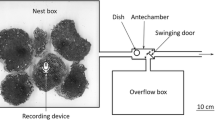Summary
Observations of the recruitment behaviour ofPheidole within the nest reveal the existence of a complex behavioural mechanism which operates in the recruitment of nestmates, including the soldiers, to mass foraging. Highly excited recruiters, arriving at the nest, perform, in addition to trail-laying, a motor recruitement display comprising running, accelerated antennal beatings and body oscillations. While moderately excited recruiters perform this display only on encounters with soldiers, highly excited recruiters display it also on encounters with workers. The release of the motor display appears to be influenced by the attractiveness of the food on one hand, and the mechanical stimulation received from the partner, on the other.
The scent trail and the motor display acting together are far more effective than the quiet scent trail recruitment. During the later stage of the experiment, when the reaction of the workers to the recruiting stimuli has already weakened considerably, the motor display still brings about recruitment. The motor display is a highly exciting factor, arousing ants from the resting to the active state. This form of alert is particularly important in the recruitment of soldiers.
The formation of recruitment depends on both the number of recruiters and the character of the recruiting performance. The releasing value of the recruiting stimuli decreases with time, as habituation increases. This process, together with excess recruitment, constitues a mechanism which controls the level and limits of recruitment and determines the time of its termination.
Résumé
Des observations sur le comportement de recrutement dePheidole, à l'intérieur du nid, révèle l'existence d'un mécanisme complexe qui aboutit au recrutement de compagnes, parmi lesquelles même des soldats, pour amasser de la nourriture. Des recruteuses extrêmement agitées, en arrivant au nid, réalisent, en plus du dépôt de traces odorantes, une parade motrice de recrutement qui comprend des va-et-vient, des battements accélérés des antennes et des oscillations du corps. Tandis que les recruteuses modérément agitées n'accomplissent cette parade qu'en présence de soldats, les recruteuses extrêmement agitées l'accomplissent également en présence de travailleuses. L'attrait de la nourriture, d'une part, et la stimulation mécanique reçue par la partenaire, d'autre part, semblent déclencher la parade motrice.
Les traces odorantes et la parade motrice tout à la fois, sont de loin plus effectives que le simple recrutement par traces odorantes. Pendant le dernier stade expérimental, alors que la réaction des travailleuses aux stimulants de recrutement s'est déjà considérablement atténuée, la parade motrice, elle, conduit encore au recrutement. La parade motrice a un pouvoir extrêmement stimulant capable de faire sortir les fourmis de leur état de repos. Cette forme d'alerte est particulièrement importante dans le recrutement des soldats.
La formation de recrutement dépend à la fois du nombre de recruteuses et du caractère de l'acte recruteur. La valeur du déclenchement des stimuli recruteurs diminue avec le temps, et avec l'habitude. Ce processus ajouté à un recrutement excessif constitue un mécanisme qui contrôle le niveau et les limites du recrutement et détermine le moment de son achèvement.
Similar content being viewed by others
Bibliographie
Blum (M. S.) andRoss (G. N.), 1965. — Chemical releasers of social behaviour. V. Source, specificity and properties of the odour trail pheromone ofTetramorium guineense.J. Insect Phys.,11, p. 857–868.
Carthy (J. D.), 1957. — The orientation of two allied species of British ants. II. Odour trail laying and following inLasius fuliginosus.Behaviour,33, p. 304–318.
Crighton (W. S.), 1966. — The habits ofPheidole ridicula Wheeler with remarks on habit patterns in the genusPheidole.Psyche,73, p. 1–7.
Goetsch (W.), 1934. — Untersuchungen über die Zusammenarbeit im Ameisenstaat.Z. Morph. Ökol. d. Tiere,28, p. 319–401.
Hangartner (W.), 1969. — Structure and variability of the individual odour trail inSolenopsis geminata Fabr.Z. vergl. Phys.,62, p. 111–120.—Hangartner (W.), 1969. Orientierung vonLasius fuliginosus Labr. an einer Gabelung der Geruchspur.Ins. Soc.,16, p. 55–60.
Leuthold (R. H.), 1968. — Recruitment to food in the antCrematogaster ashmaedi.Psyche,75, p. 334–350.
Macgregor (E. C.), 1948. — Odour as a basis for oriented movements in ants.Behaviour,1, p. 267–296.
Sudd (Y. H.), 1960. — The foraging method of Pharaoh's ant,Monomorium pharaonis (L.).Anim. Beh.,8, p. 67–76.
Sudd (Y. H.), 1957. — Communication and recruitment in Pharaoh's ant.Brit. J. Anim. Beh.,3, p. 104–109.
Szlep (R.) andJacobi (T.), 1967. — The mechanism of recruitment to mass foraging in colonies ofMonomorium andTapinoma.Ins. Soc.,14, p. 25–40.
Wilson (E.), 1962. — Chemical communication among workers of the fire antSolenopsis saevissima (Fr. Smith). I. The organization of mass-foraging.Anim. Beh.,10, p. 134–137.
Author information
Authors and Affiliations
Rights and permissions
About this article
Cite this article
Szlep-Fessel, R. The regulatory mechanism in mass foraging and the recruitment of soldiers inPheidole . Ins. Soc 17, 233–244 (1970). https://doi.org/10.1007/BF02224715
Issue Date:
DOI: https://doi.org/10.1007/BF02224715




